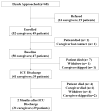Patterns of depressive symptoms in caregivers of mechanically ventilated critically ill adults from intensive care unit admission to 2 months postintensive care unit discharge: a pilot study
- PMID: 22430242
- PMCID: PMC3330166
- DOI: 10.1097/CCM.0b013e3182451c58
Patterns of depressive symptoms in caregivers of mechanically ventilated critically ill adults from intensive care unit admission to 2 months postintensive care unit discharge: a pilot study
Abstract
Objective: To examine trajectories of depressive symptoms in caregivers of critically ill adults from intensive care unit admission to 2 months postintensive care unit discharge and explore patient and caregiver characteristics associated with differing trajectories.
Design: Longitudinal descriptive study.
Setting: Medical intensive care unit in a tertiary university hospital.
Subjects: Fifty caregivers and 47 patients on mechanical ventilation for ≥4 days.
Interventions: None.
Measurements and main results: Caregivers completed measures assessing depressive symptoms (Short version Center for Epidemiologic Studies-Depression Scale 10-items), burden (Brief Zarit Burden Interview), and health risk behaviors (caregiver health behaviors) during intensive care unit admission, at intensive care unit discharge, and 2 months postintensive care unit discharge. Group-based trajectory analysis was used to identify patterns of change in shortened Center for Epidemiologic Studies-Depression Scale scores over time. Two trajectory groups emerged: 1) caregivers who had clinically significant depressive symptoms (21.0±4.1) during intensive care unit admission that remained high (13.6±5) at 2 months postintensive care unit discharge (high trajectory group, 56%); and 2) caregivers who reported scores that were lower (10.6±5.7) during intensive care unit admission and decreased further (5.7±3.6) at 2 months postintensive care unit discharge (low trajectory group, 44%). Caregivers in the high trajectory group tended to be younger, female, an adult child living with financial difficulty, and less likely to report a religious background or preference. More caregivers in the high trajectory group reported greater burden and more health risk behaviors at all time points; patients tended to be male with poorer functional ability at intensive care unit discharge. Caregivers' responses during intensive care unit admission did not differ in regard to number of days patients were on mechanical ventilation before enrollment.
Conclusion: Findings suggest two patterns of depressive symptom response in caregivers of critically ill adults on mechanical ventilation from intensive care unit admission to 2 months postintensive care unit discharge. Future studies are necessary to confirm these findings and implications for providing caregiver support.
Conflict of interest statement
Conflicts of Interest: None reported
Figures


Comment in
-
Time for a formal assessment, treatment, and referral structure for families of intensive care unit patients.Crit Care Med. 2012 May;40(5):1675-6. doi: 10.1097/CCM.0b013e318249594a. Crit Care Med. 2012. PMID: 22511159 No abstract available.
References
-
- Angus DC, Carlet J. Surviving intensive care: a report from the 2002 Brussels Roundtable. Intensive Care Med. 2003;29(3):368–377. - PubMed
-
- Daly BJ, Rudy EB, Thompson KS, Happ MB. Development of a special care unit for chronically critically ill patients. Heart Lung. 1991;20(1):45–51. - PubMed
-
- Girard K, Raffin TA. The chronically critically ill: to save or let die? Respir Care. 1985;30(5):339–347. - PubMed
Publication types
MeSH terms
Grants and funding
LinkOut - more resources
Full Text Sources
Medical

